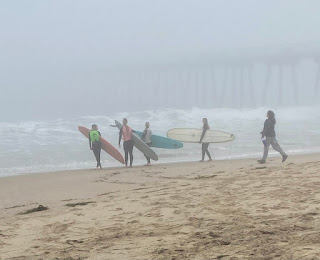Tulare Fair Tuesday Surf & Culture Report
Today we have a photo of Sully examining some of the winners in the "Preserves" section of the Tulare Fair. Yes, we know, Sully looks pretty well preserved himself, but we digress. We were astounded to discover how many different categories of items that could be judged. So you could win a blue ribbon in Fig Jam, or Strawberry Jam or Quince Paste. In all of the jam category there is a "Best of Show." This ends up being the best of ALL the jams. So you can win 3 blue ribbons with your blueberry, boysenberry and kiwi jams only to have Mary Fagundes of Elbow Creek get best of show with her Kumquat number. Hey, it's a jungle out there...
Overcast and hazy out there this morning with barely 2 miles visibility. Winds kicked up out of the SW by 3.2kts pretty early and shut Hermosa down before Les Congiliere could get his first period surfers out of the water.. The air temperature was 62.2° and the water is still nice at 69.8°, although we noticed that the 46025 buoy is reading some 65° water a few miles out. High tide is at 11:41am +5.8' and low tide will be at 6:52pm +0.5'. The buoy is reading a 2.6' swell out of 225° SW. We called it 2' this morning and we're hoping the swell gets a bit of a kick from some of that northern weather they've been having.
Since today is the equinox we thought we'd print this and take care of some of those nagging questions you've been having!
The September Equinox Explained
The September equinox occurs at 21:19 (or 9:19pm) Coordinated Universal Time (UTC) on September 22, 2009. It is also referred to as the autumnal or fall equinox in the northern hemisphere, as well as the spring or vernal equinox in the southern hemisphere (not to be confused with the March equinox). This is due to the seasonal contrasts between both hemispheres throughout the year.
To find the September equinox date in other time zones or other years, please use the Seasons Calculator.
This illustration, which shows an example of the September equinox, is not to scale.
What happens during the September equinox?
The sun crosses the celestial equator and moves southward in the northern hemisphere during the September equinox. The location on the earth where the sun is directly overhead at solar noon is known as the subsolar point. The subsolar point occurs on the equator during the September equinox and March equinox. At that time, the earth's axis of rotation is perpendicular to the line connecting the centers of the earth and the sun. This is the time when many people believe that the earth experiences 12 hours of day and night. However, this is not exactly the case.
Dispelling the "exactly 12 hours of daylight" myth
It is important to note that day and night during the September equinox is not exactly equal length. During the time of the September and March equinoxes many regions around the equator have a daylight length of about 12 hours and six-and-a-half minutes. Moreover, the day is slightly longer in places that are further away from the equator and the sun takes longer to rise and set in these locations.
According to the US Naval Observatory the dates of "equal" day and night occur about February 25 and October 15 at a latitude of five degrees in the northern hemisphere. They occur around March 17 and September 26 at a latitude of 40 degrees. On the dates of the equinoxes, the day is about seven minutes longer than the night at latitudes up to about 25 degrees, increasing to 10 minutes or more at a latitude of 50 degrees.
Why is the equinox date not the same each year?
While the September equinox occurs on September 22 in 2008 and 2009, it occurs on September 23 in 2010 and 2011 (UTC). The September equinox has also occurred on September 24(UTC), with the last occurrence on that date being 1931. The next time a September 24 equinox occurs will be in the year 2303. Moreover, a September 21 equinox will occur in 2092.
There are a few explanations on why the equinox dates differ in the Gregorian calendar. The varying dates of the equinox are mainly due to the calendar system – most western countries use the Gregorian calendar, which has 365 days in a year, or 366 days in a leap year. According to the National Maritime Museum, the equinoxes generally occur about six hours later each year, with a jump of a day (backwards) on leap years. An extra day is added in a leap year to minimize a gradual drift of the equinox date through the seasons.
As for the tropical year, it is approximately 365.242199 days, but varies from year to year because of the influence of other planets. A tropical year is the length of time that the sun takes to return to the same position in the cycle of seasons, as seen from earth. The exact orbital and daily rotational motion of the Earth, such as the "wobble" in the earth's axis (precession), also contributes to the changing solstice dates.
"When the surf breaks, we'll fix it..."
The Professor!!



